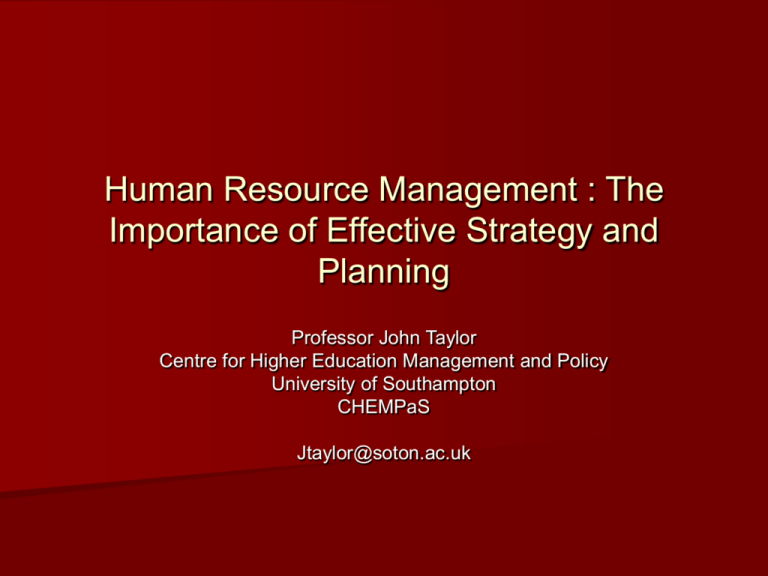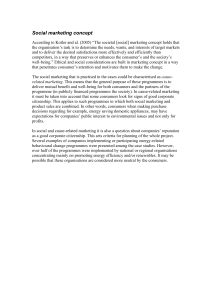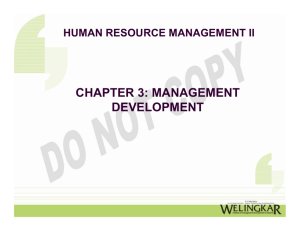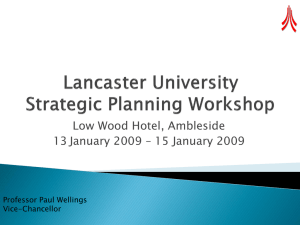Human Resource Management : The Importance of Effective
advertisement

Human Resource Management : The Importance of Effective Strategy and Planning Professor John Taylor Centre for Higher Education Management and Policy University of Southampton CHEMPaS Jtaylor@soton.ac.uk Change in Higher Education Massification – growth in student numbers; increasing diversification in students Pressures on funding – reductions in unit of resource; importance of value for money The quality movement – quality assurance and assessment Globalisation and internationalisation – new approaches, new ways of working New technology – in teaching, research and management Markets and competition NO COUNTRY AND NO INSTITUTION IS IMMUNE FROM THESE CHANGES; NO ROOM FOR COMPLACENCY The Importance of Planning “A conscious process by which an institution assesses its current state and the likely future condition of its environment, identifies possible future states for itself, and then develops organisation strategies, policies and procedures for selecting and getting to one or more of them” (Petersen, 1999) Some important assumptions: • That the institution and its members are concerned about the future • That they choose to try to influence the future rather than be shaped by external factors or by key individuals • That they accept that some attempt to evaluate activities and to understand the environment can lead to benefits Some key words: “a conscious process” – deliberate and non-accidental “current state” – analysis of the present position “future states” – a forward view “organisation strategies” – establishment of targets and development of the means for achieving them “selecting” – the exercise of judgement “getting to one or more of them” – clear outcomes and deliverables; emphasis on implementation The Planning Cycle – Planning, Documentation, Implementation, Monitoring The Importance of Human Resources Higher Education is a knowledge business – depends on the quality of its staff Growth of markets and competition for staff – with other sectors, with other institutions The quality movement – focus on staff, no “hiding places” Pressure on funding – importance of staff productivity and performance Globalisation Change management Legal environment – health and safety, conditions, equal opportunities, European legislation Strategic Plans and Operational Plans Strategic or Corporate Plan – sets overall aims and objectives Operational or Tactical Plans – set specific targets and actions, by organisational units (Faculty, Department) or by activity (teaching, research, estates, human resources) Individual Plans – what the individual has to do A Human Resources Strategy will aim to create and maintain a workforce that is well motivated, appropriately trained, equitably rewarded and which performs effectively in pursuing the institution’s objectives Linking Institutional Planning and the Human Resources Strategy Understanding the external environment. Changing demand for subjects and research can mean too few or too many staff in particular areas. Knowledge of market data – demand and supply of different categories of staff. Review of current performance in HR related areas – recruitment and retention, employment relations, equal opportunities Data provision eg length of service, staff movements, nature of contracts, age, sex, salaries, ethnicity. Broken down by organisational units. Staff surveys – satisfaction, training needs Importance of HR involvement in strategic and operational planning from an early stage Some Characteristics of a good Human Resources Strategy Three key elements: • Diagnostic – a comprehensive and systematic evaluation of current practice and performance to identify both where improvement is required and where policies and institutions are working well • Aspirational – a vision of effective HR practices which produce specific outcomes that contribute to achieving the institution’s strategy, underpinned by clear values and principles • Developmental – a plan for achieving progress and building greater capacity to bring about change in the future (bearing in mind that effective human resource management depends as much on good quality line management as it does on skilled human resorce professionals) Clear Targets SMART targets – specific, measurable, agreed, realistic, time-limited Input targets eg appointing a new member of staff Process targets eg developing new policies or procedures, or undertaking a review of practice Output targets eg producing a report introducing a new payments or job evaluation scheme Outcome targets eg increasing the number of women in management positions or the proportion of people with disabilities Performance measures Project management – subprojects, milestones Resource Allocation MUST be a clear link between human resource plans and resource allocation Clarity of approach: actions-responsibilities-outcomes-timescalecost Monitoring Assessment of progress against input. Process and output targets Summative evaluation – what works and what doesn’t work. Formative process Problems of identifying cause and effect Importance of good feedback Implementation is assisted by: • Adequate levels of involvement • Feedback on performance • Focus on what is achievable • Clear allocation of responsibilities • Effective training and support • Incentives and rewards Key Issues: Recruitment and Retention Data collection Comparative analysis Identification of problems – particular disciplines (eg computing, management, economics), particular categories of staff (eg electronics technicians, cleaners), particular regions (eg big cities) Some possible actions – improving the recruitment process, startup packages, pay and rewards, market supplements, job evaluation, career routes, fast-track promotion, training and development Key Issues: Staff Development and Training Necessary to enhance the institution’s skills and knowledge base Important to identify needs at ALL levels All categories of staff should be involved Programmes require regular evaluation – problems of relevance Different forms of staff development: • Induction programmes • Programmes for new academic staff (often linked with probation) • Skills programmes – particular activities, new technology, updating • Management development programmes – leadership and management Key Issues: Equal Opportunities Data collection Staff development Possible actions – awareness raising, flexible working, improvements to recruitment processes and literature, targeted skills development, progression Job evaluation – equal pay for equal work Key Issues: Staff Profiles Data collection Audit of existing staff – current staff numbers, distribution by grade/level of responsibility, skills profiles, age profiles (succession planning, “new blood”), patterns of leavers and joiners (high and low turnover), which posts are difficult to fill, staffing costs, gender profiles, pay distribution External environment – national and local labour markets, comparative analysis Link with institutional strategies – where will more/less staff be needed Possible actions – training/retraining, redeployment, severance Key Issues: Performance Performance review – vital in improving staff effort Must be regular All staff are entitled to feedback Formative process Rewarding good performance – monetary and non-monetary Tackling poor performance – clear agreed targets, opportunities for training, monitoring, training for managers, clear disciplinary procedures (including appeals) Human Resource Strategy: Professional Services What are “professional services”? *”Administration”, “Non-academic staff”, “The Centre”, “Management”, “Support staff”, or simply “them”! Professional services include: • Finance • Estates • Student and Registry Services (admissions, examinations, progress) • Planning and institutional research • Marketing • Research support • External relations • Fundraising Members of the professional services have a crucial role to play in the running of their universities: * Key advisers in decision-making process • Efficient and effective operation • First point of contact for students and other stakeholders • Responsible for the delivery of critical services Staff Development for Professional Services Career development – recruitment, training and enhancement, performance and rewards, retention Training programmes for new staff in professional services (wide range of backgrounds) Specialist training and career development – professional qualifications Training programmes for senior staff in professional services Formal programmes; Continuing Professional Development Some particular themes – broadening and deepening, sharing expertise and experience, formative and process benchmarking, leadership and management Professor John Taylor Centre for Higher Education and Policy at Southampton CHEMPaS Jtaylor@soton.ac.uk +44 (0)23 8059 6892






